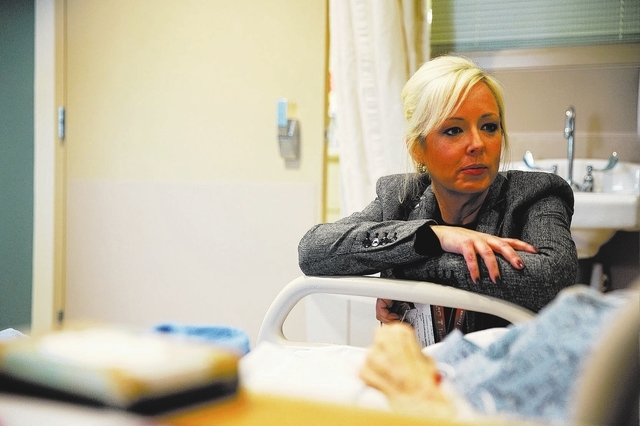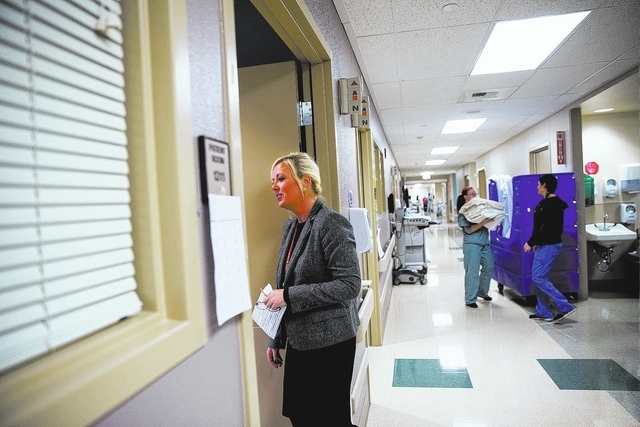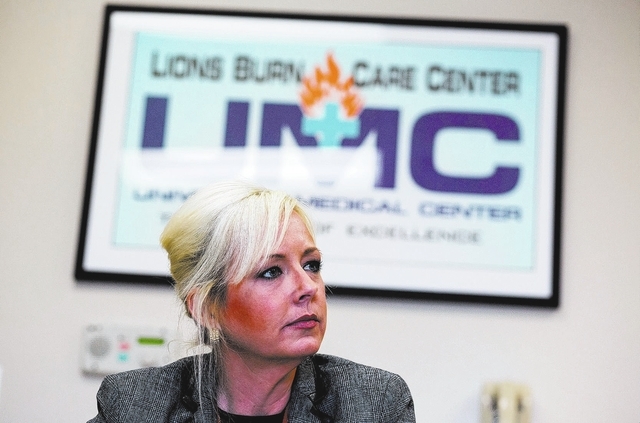Experience enhances empathy




The woman’s hands shake. Her face, covered in protective ointment, glistens in the overhead lights. Little hair covers her singed scalp.
This is the first time that psychotherapist Cara Goodman has met the burn victim, who grimaces as she says in a voice that can barely be heard, “I did a stupid thing.”
“Ninety-nine percent of us do stupid things,” Goodman says, who has bent down to hear the woman. “You had an accident.”
“It was so stupid,” the woman replies, closing her eyes.
Haltingly, with few details, the skeleton of her story comes out — the combination of a lighter, a cigarette and wind set her afire. The woman shakes her head, seemingly still unable to believe that a fire could get started quickly enough to leave her in this condition.
Goodman lets the woman, whose pain medication is making it difficult for her to keep her eyes open, know that she is available to talk about whatever she wants at a later time.
“Do you mind if I come back later?” the 40-year-old Goodman says to the woman.
“No, no at all,” the burn victim says.
And so the first baby steps toward what Goodman hopes will be psychological healing for the woman have been taken. Psychological distress, she says later, occurs in most survivors of severe burn injuries. Patients, including young children, fear ridicule or social rejection because of changed appearance or abilities.
“I have to first establish some kind of relationship,” Goodman says. “Later, the conversation is more comfortable and often a burn victim will really start talking about what happened. They’ll go through the sights, sounds and smells of what happened and often there’s guilt. We have to change the thought process, show there is no benefit to that thinking. Massive guilt happens a lot with parents, even when they had nothing to do with what happened to their children. They think somehow they should have protected their children. I’ve seen that with my own parents.”
Goodman, the daughter of the Mayors Goodman — current Mayor Carolyn Goodman and former Mayor Oscar Goodman — says the catalyst for her volunteering her services two days a week at UMC stems in large part from her time there as a patient beginning about 10 years ago. At that time, her frightened parents didn’t know which way to turn after she came down with an illness that no doctor in town could diagnose.
She had symptoms that included severe abdominal pain, numbness, nausea, agitation and motor weakness that resulted in her ending up temporarily in a wheelchair. It took several months just to get the diagnosis — acute intermittent porphyria, a rare metabolic disorder that is characterized by deficiency of the enzyme porphobilinogen deaminase.
Then it took six years to get the condition under control. During that time, she’d sometimes be in the hospital for a month or more as doctors worked to find the right drug therapy and diet for her specific type of the disease.
“My mother kept pleading with doctors not to give up,” Goodman recalls. “It’s a genetic disorder but I’m adopted, so my parents knew nothing about it. I think they suffered more than I did. When I was undergoing all that, that’s when I realized that in hospitals it was important not only to focus on the physical problem. Both for patients and their loved ones there is often a psychological component that must be dealt with.”
For years, Greg Fusto, now UMC’s chief nursing officer, had wanted a psychotherapist to work with patients at UMC’s burn and trauma units, but there was no funding for such a position.
“Someone who gets burned or traumatized really has self-esteem issues,” he says. “They need help through disappointment and depression and we were only working with their physical issues.”
One day, about 18 months ago, Fusto was having lunch with Carolyn Goodman, a longtime supporter of UMC, when the mayor introduced him to her daughter, who also was in the restaurant. They began to talk and he learned about Cara Goodman’s work in mental health. He told the psychotherapist, a Stanford University graduate already counseling foster children in Las Vegas, that he could really use someone with her talents at UMC.
Remembering what she calls “the incredible care I got at UMC,” Goodman said she would be happy to volunteer. It took six months to integrate her into the system, in part because of legal issues regarding professional responsibility that had to be addressed. Fusto couldn’t be happier with her efforts in the year she’s volunteered at the hospital.
“She has just done amazing,” he says. “We’ve split her time between trauma and the burn unit. We had a young gentleman who lost two limbs who didn’t even want to see his kids anymore. He was really having self-esteem and anger issues. She worked with him so he was reunited with his family, happy to get on with his life.
“You really have to care about people to do what she does. It’s not a job for the faint of heart. You really have to understand emotions and bond with people who are really hurting.”
Goodman, understanding that those dealing with horrific injuries can often gain strength from talking with those who have been in similar situations, has started survivor support groups for both children and adults.
Sandra McGuire, a Bullhead City, Ariz., resident who has recovered from critical burn injuries suffered in a flash fire aboard a boat, says she finds the support group “incredibly helpful.”
“We know we’re not alone when we can talk with others who’ve been through what we have,” she says. “People who haven’t been through burns just can’t imagine what it’s like. It really helps our recovery. We need to open up. Sometimes we almost feel like sisters and brothers. We can cry and rant and rave.
“Cara’s been through some difficult things herself so she knows how important it is for us to just talk.”
In her own psychotherapeutic interventions with patients, Goodman often uses cognitive behavioral therapy, where a patient and therapist work together to craft what are sometimes called “homework assignments,” to address dysfunctional emotions and behaviors.
Assignments can be as simple as a patient suffering with anxiety and depression talking to a stranger. He may not have wanted to see anyone after an accident. If the assignment turns out to be too difficult, Goodman and her patient may work out something easier.
“You have to help people learn again how to cope with the world,” says Goodman, who also works on relaxation and breathing exercises with patients, and often parents, to help them deal with stress.
Guided imagery techniques, she says, often help. A person can receive a relaxed state, say, when he is helped to imagine all the details of a safe, comfortable place, such as a beach.
“I encourage patients and parents of children who’ve been hurt to get more counseling help after they leave the hospital because I often don’t get that much time with them here,” she says.
Jose Eduardo Enriquez, the clinical manager of the burn unit, says he is optimistic that someday UMC will find the funding to bring Goodman to the hospital full time.
“She has a way of keeping things calm,” he says. “I remember one day a mother and child were arguing and she was able to get the mother to calm down very quickly. Nurses and doctors are very good at dealing with the physicial but we’re not that good at dealing with the emotional issues you so often see in the burn and trauma unit. She’s very mellow, empathizes very well.”
Goodman acknowledges her own family has been through some trying times recently as a result of critical head injuries suffered in December by her brother, Eric Goodman, a justice of the peace who was found incoherent in a men’s restroom at a Summerlin park.
Authorities still aren’t sure if he had a medical episode or was attacked during a training jog. Goodman says her brother, who was treated at UMC, should be able to recover completely.
“I don’t do any counseling with him,” she says. “It’s strictly a sister talking to her brother.”
Goodman finds herself spending more and more time at UMC when she isn’t counseling foster children.
“There is just such a need,” she says a day after she first saw the woman whose face was severely burned. “I feel like I barely have time to touch base with patients who are going through terrible times. Just like that woman I saw whose face was burned. She was already discharged from the hospital because her physical situation had gotten better but I think she’s going to have some tough emotional issues ahead. I only got to see her once. I pray she gets more counseling. What she’s facing isn’t easy.”
Paul Harasim is the Review-Journal medical reporter. Contact him at pharasim@reviewjournal.com or 702-387-2908.












